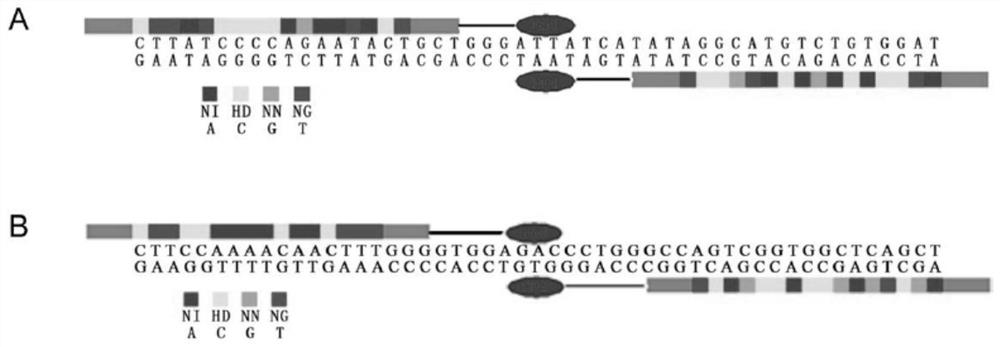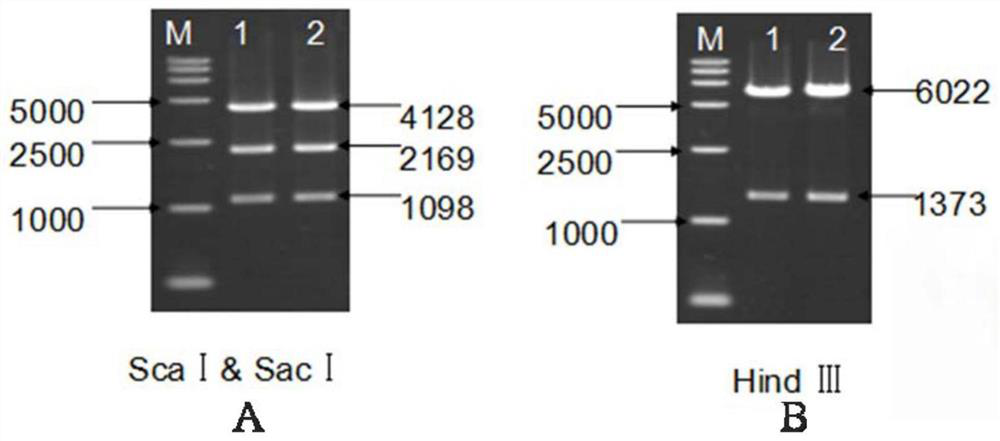Construction method of donor pig capable of being used for xenogeneic organ transplantation
A construction method and a technology for donor pigs, applied in the field of animal genetic engineering, can solve the problems that hinder the wide application of allogeneic organ transplantation and the shortage of organ resources.
- Summary
- Abstract
- Description
- Claims
- Application Information
AI Technical Summary
Problems solved by technology
Method used
Image
Examples
Embodiment 1
[0043] Example 1 Construction of GGTA1-TALENs
[0044] (1) Design of TALENs target sequences
[0045] According to the principle of TALENs target sequence design, the target sequence was designed in exon 6 of the pig GGTA1 gene (nucleotide sequence shown in SEQ ID No. 1), and two pairs of TALENs were constructed, TALENs Set1 and TALENs Set2. See the TALENs target recognition sequence. figure 1 A and B in. The lengths of the TALENs Set1 target recognition sequences were 17bp and 16bp, respectively, and the length of the spacer sequence was 16bp; the lengths of the TALENs Set2 target recognition sequences were 16bp and 16bp, respectively, and the length of the spacer sequence was 19bp.
[0046] Table 1 TALENs target sequences
[0047]
[0048] Note: The uppercase letters on both sides are the recognition sequence (L) of the left arm TALEN module and the recognition sequence (R) of the right arm TALEN module, respectively, and the lowercase letters in the middle are the spac...
Embodiment 2
[0055] Example 2 Construction of pCAG-HLA-G5-neo expression vector
[0056] The HLA-G5 gene fragment and the pCAG-neo vector were double-enzyme digested with the same endonuclease, and then ligated at 16°C overnight after the gel was recovered, and the single clones were transformed and picked for restriction enzyme digestion and sequencing identification. The total length of the constructed pCAG-HLA-G5-neo expression vector was 7395 bp, and three target bands with sizes of 4128 bp, 2169 bp and 1098 bp were obtained by double digestion with ScaI and SacI ( image 3 A); the target bands with sizes of 6022bp and 1373bp appeared after single digestion with HindIII ( image 3 B).
[0057] The two plasmids identified by enzyme digestion were sent to BGI for sequencing and identification. The sequencing results showed that both clones were correct, and No. 1 was randomly selected as the final expression vector. The expression vector was linearized with Sac I endonuclease, and the ...
Embodiment 3
[0058] Example 3 GGTA1 gene targeting PFF mediated by TALENs transfection
[0059] (1) Isolation of primary Bama pig fetal fibroblast PFF
[0060] The pig fetuses were taken out by caesarean section on the 35th day of pregnancy, soaked in PBS supplemented with 50μg / mL kanamycin, 100IU / mL penicillin, and 100g / mL streptomycin and brought back to the laboratory. Carefully peel off the fetus and afterbirth, place the fetuses in PBS (containing 100IU / mL penicillin, 100 g / mL streptomycin), first take the head, limbs, internal organs and other tissues, and put them in EP tubes for the next step of genome extraction. . The remaining fetal tissue was washed 5 times, cut into pieces, added with 10 mL of porcine primary PFFs to separate the digestion solution, and placed in a 38°C incubator for digestion for about 4 hours. Then, transfer it to a 15 mL centrifuge tube, 1000 rpm, 5 min, collect the cells, discard the supernatant, wash the cells twice with PFFs medium, and then culture wi...
PUM
 Login to View More
Login to View More Abstract
Description
Claims
Application Information
 Login to View More
Login to View More - R&D
- Intellectual Property
- Life Sciences
- Materials
- Tech Scout
- Unparalleled Data Quality
- Higher Quality Content
- 60% Fewer Hallucinations
Browse by: Latest US Patents, China's latest patents, Technical Efficacy Thesaurus, Application Domain, Technology Topic, Popular Technical Reports.
© 2025 PatSnap. All rights reserved.Legal|Privacy policy|Modern Slavery Act Transparency Statement|Sitemap|About US| Contact US: help@patsnap.com



